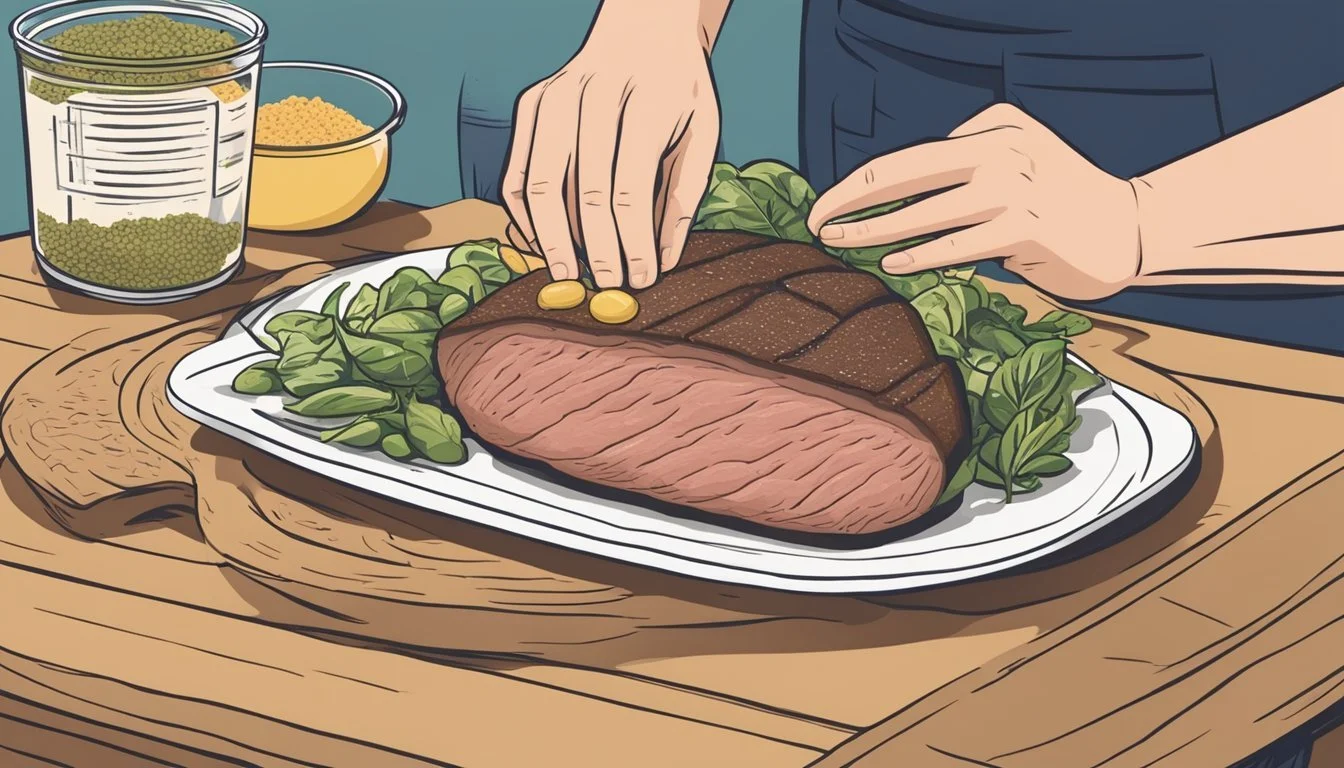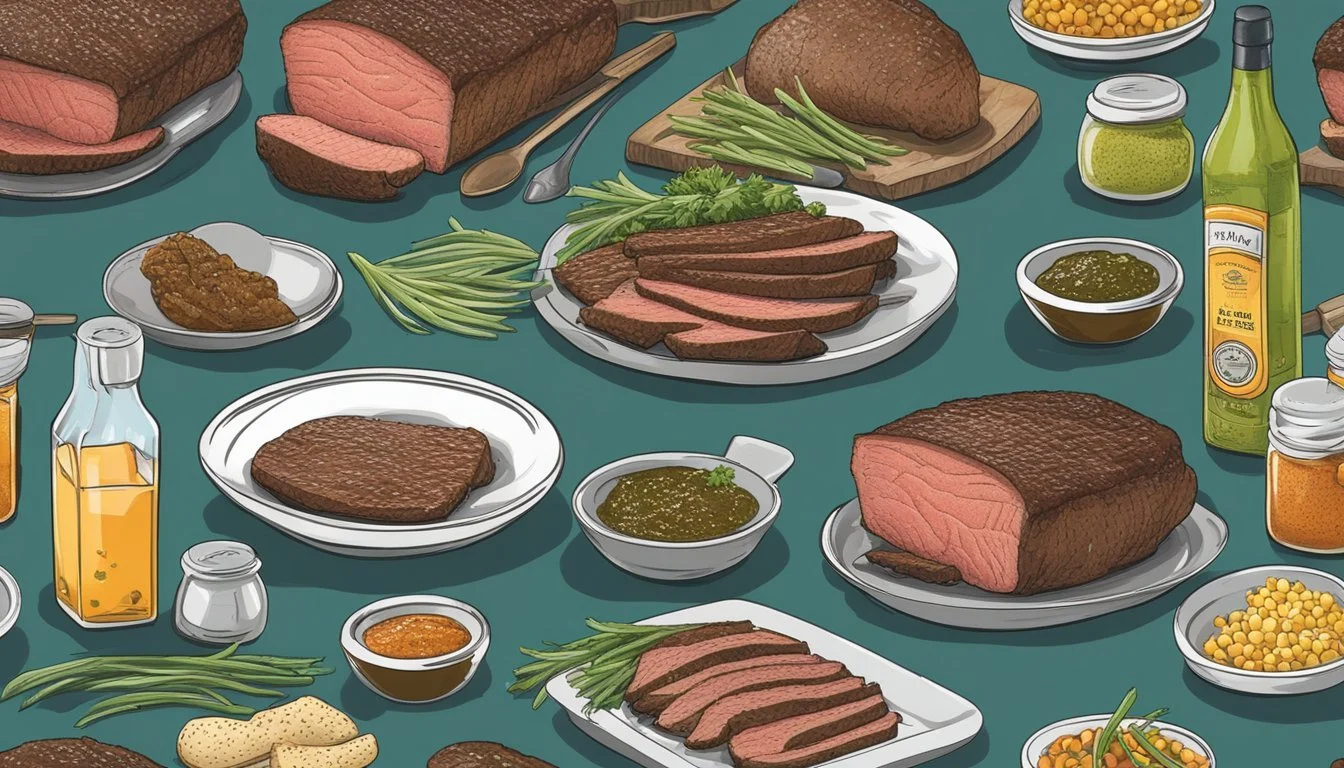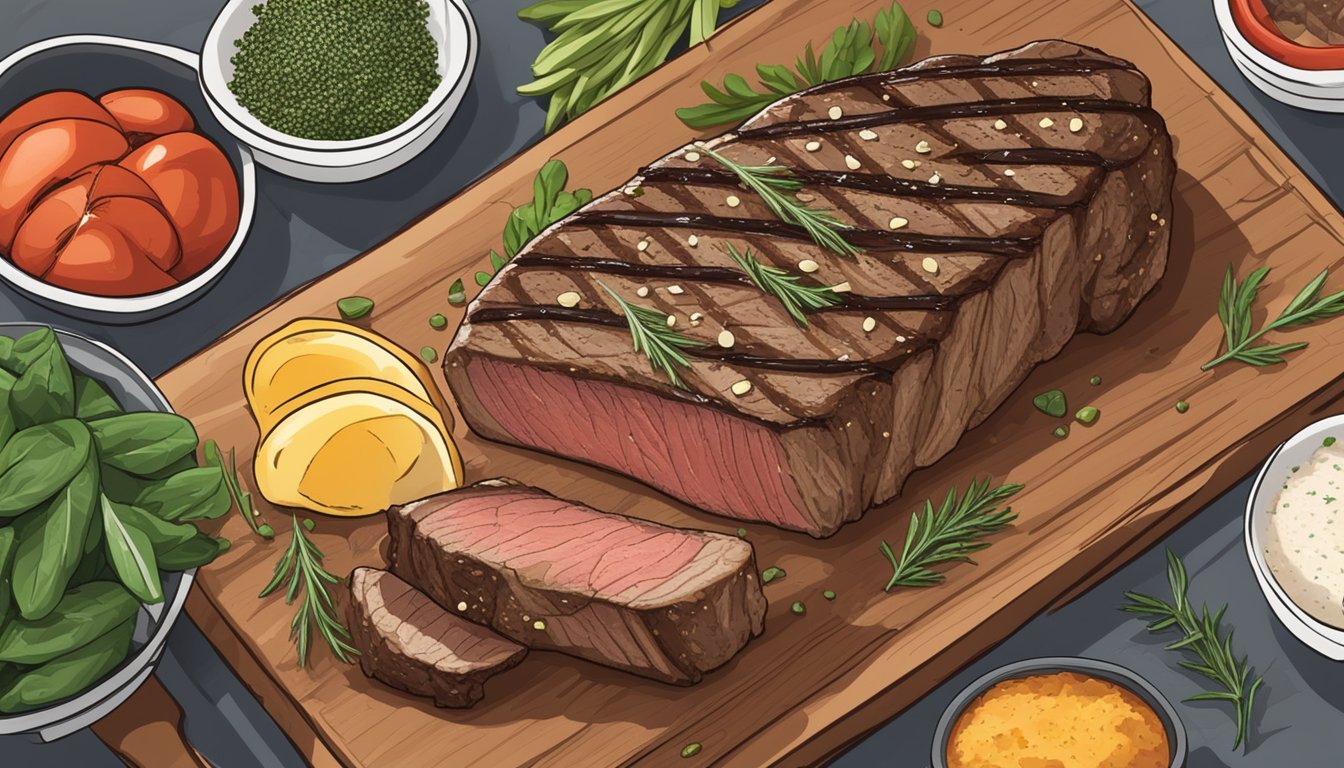Is London Broil Gluten-Free?
Unveiling the Facts for Conscious Eaters
When discussing the gluten content of foods, it's important to understand what gluten is and where it's typically found. Gluten is a group of proteins present in wheat, barley, and rye, and it can be a concern for individuals with celiac disease or gluten sensitivity. London broil, in its purest form, is a method of cooking a lean cut of beef by marinating and then grilling or broiling it. Since meat is naturally gluten-free, a plain London broil without additives or marinades would also be gluten-free.
The complications with gluten arise when considering the preparation and cooking methods of London broil. Marinades, rubs, and seasonings often contain gluten or are subject to cross-contamination during processing. For a London broil to be confidently considered gluten-free, all ingredients used in the marination and cooking process must be verified as such. Additionally, cross-contamination in the kitchen, particularly in establishments that also handle gluten-containing foods, must be diligently avoided to ensure a truly gluten-free meal.
Understanding London Broil
In this section, you will learn about London Broil, how it can fit into a gluten-free diet, and the significance of using quality beef to ensure a wholesome meal. Whether you're looking for a hearty steak packed with protein or managing a gluten-sensitive diet, understanding these facets is crucial.
Defining London Broil
London Broil originally refers to a cooking method rather than a specific cut of beef. It involves marinating a lean piece of beef, then broiling or grilling it until medium-rare and slicing it thinly against the grain. London Broil cuts are typically flank or top round steak, known for their rich beefy flavor and potential tenderness when prepared correctly.
Gluten-Free Considerations
When it comes to maintaining a gluten-free diet, the primary concern with London Broil is the marinade or seasoning used in its preparation. The steak itself is a gluten-free source of protein, as long as it is not contaminated. Marinades often contain soy sauce or Worcestershire sauce, which can include gluten unless specifically stated otherwise. Therefore, using gluten-free alternatives for marinades is essential for individuals with celiac disease or gluten sensitivities.
The Importance of Quality Beef
The quality of the beef used for London Broil cannot be overstated. Quality beef ensures not only a rich, savory flavor but also a good source of protein and other nutrients. It is advisable to select beef cuts that are:
Bright red in color
Have a firm texture
Uniform in thickness to ensure even cooking
Choosing top-grade meats, ideally from grass-fed cattle, can also contribute to a more desirable outcome both in terms of health and taste.
Selecting Ingredients
When embarking on the preparation of a gluten-free London Broil, it is crucial to meticulously select ingredients that are free of gluten while ensuring they contribute to the rich flavor of the dish.
Choosing the Right Beef
For a London Broil, one should opt for a top round beef cut, known for its leanness and suitability for marinating and grilling. This cut is inherently gluten-free, but it is important to avoid cross-contamination by purchasing from a source that does not process meats with gluten-containing products.
Gluten-Free Marinade Ingredients
The marinade is pivotal for infusing flavor and tenderizing the beef. To create a gluten-free marinade, combine these key ingredients:
3-4 cloves of garlic, minced
¼ cup of olive oil
2 tablespoons of balsamic vinegar
Optionally, 1 tablespoon of gluten-free soy sauce or tamari for umami depth
A dash of salt and pepper for seasoning
Ensure all vinegar and sauces confirm gluten-free status on labeling to avoid the presence of hidden gluten.
Alternative Seasonings and Sauces
For added flavor without the glaze of a marinade, dry rubs or alternative sauces can be employed:
Create a rub with a mixture of salt, pepper, and other gluten-free spices of choice.
Utilize gluten-free Worcestershire sauce as a condiment or part of a more simplified marinade.
When exploring oils, besides olive, ensure they are pure and not blends that may carry gluten.
Adherence to these guidelines helps create a rich, flavorful London Broil that aligns with gluten-free dietary requirements.
Preparation Techniques
When preparing London Broil, one should be mindful of marination, heating methods, and final preparation steps such as resting and slicing to ensure the dish is both flavorful and tender.
Marinating the London Broil
Marinating is a crucial step for infusing the London Broil with flavors and begins with selecting gluten-free ingredients. Typically, the marinade can include a mixture of vinegar, oil, garlic, and gluten-free soy sauce or Worcestershire, combined with seasonings like sea salt and black pepper. It is essential to marinate the meat in the refrigerator at least 4 hours or, ideally, overnight, turning it once to ensure even coverage.
Preheat and Cooking Procedures
For grilling, one should preheat the grill to a medium-high temperature, which is approximately 400-425 degrees Fahrenheit (205-218 degrees Celsius). The London Broil should be grilled for about 7-10 minutes on each side for medium-rare, or until it reaches the desired internal temperature. Cooking times can vary, so using a thermometer is recommended:
125°F (52°C): Rare
135°F (57°C): Medium Rare
145°F (63°C): Medium
For oven preparations, preheat the oven to 350 degrees Fahrenheit (175 degrees Celsius). Cook the London Broil in the oven for approximately 7-9 minutes per side, depending on the desired level of doneness.
Resting and Slicing for Optimal Tenderness
After cooking, it is imperative to let the meat rest. Place it on a cutting board and tent it loosely with foil for about 10 minutes. This allows the juices to redistribute, resulting in a juicier cut. For optimal tenderness, slice the meat across the grain into thin strips. This technique reduces the chewiness of the dense muscle fibers, enhancing the eating experience.
Cooking the London Broil
When preparing London Broil, one can achieve a succulent, gluten-free dish by focusing on the method of cooking. Whether grilling, broiling in the oven, or exploring alternative methods, maintaining the correct heat and timing is crucial for desired doneness.
Grilling to Perfection
For grilling, allowing the meat to reach room temperature beforehand ensures even cooking. One should preheat the grill to medium-high heat. Grilling the London Broil for approximately 7 to 10 minutes on each side will typically yield a medium-rare finish, characterized by a warm, red center. If a more well-done steak is preferred, additional cooking time will be necessary.
Preheat: Medium-high heat
Cook time: 7-10 minutes per side (medium-rare)
Broiling in the Oven
Broiling requires preheating the oven's broiler. Place the London Broil in the broiler pan and position it so that the meat is approximately 4 inches from the heat source. For a medium-rare outcome, a cook time of about 12-14 minutes is recommended, flipping the meat halfway through the process. Resting the meat for about 10 minutes post-cooking allows for even juice distribution.
Preheat: Oven broiler
Distance from heat: 4 inches
Cook time: 12-14 minutes, flip halfway (medium-rare)
Rest: 10 minutes
Alternative Cooking Methods
Other cooking methods include using a cast-iron skillet for a seared finish. Heat the skillet over medium-high heat and cook the steak to the desired level of doneness, typically a few minutes per side for a sear. One can also achieve a delicious result by cooking at a lower temperature for a longer period, which can be beneficial for thicker cuts that need to cook through without burning the exterior.
Sear: Cast-iron skillet, medium-high heat
Low and slow: Thicker cuts, avoid burning
Nutritional Information
London Broil is appreciated for its robust flavor and lean profile. It is a nutritious choice for those monitoring their gluten intake and seeking healthful options in their diet.
Calories and Macronutrients
A typical serving size of London Broil, which is approximately 3 ounces, contains:
Calories: About 180-200 calories
Protein: Around 24 grams, making it a high-protein food choice
Fat: Approximately 7 grams, with minimal saturated fat content
Cholesterol: Roughly 50-60 milligrams
London Broil's low-fat content makes it suitable for low-fat dietary needs and its high protein aids in muscle building and repair.
Vitamins and Minerals
This cut of beef is not only lean but also packed with vital nutrients which include:
Iron: Essential for healthy blood function, oxygen transport
Zinc: Supports immune function, cellular metabolism
Potassium: Helps with muscle function, nerve signals, and fluid balance
Calcium: Minimal calcium content, benefits bone health
B Vitamins: Contributing to energy metabolism and red blood cell formation
London Broil generally does not contain significant amounts of Vitamin A or Vitamin C. It is, however, rich in B vitamins, particularly niacin, vitamin B6, and vitamin B12, and provides minerals such as iron and zinc. The sodium content can vary depending on preparation and seasoning but is naturally low in unseasoned cuts.
Accompaniments and Serving Suggestions
When presenting London Broil, a variety of side dishes can enhance the dining experience. It’s important to choose accompaniments that not only complement the flavors of the flank steak but also meet dietary needs, such as gluten-free options.
Sides to Complement London Broil
London Broil is traditionally served with side dishes that can stand up to its robust flavor. Potatoes are a classic choice, capitalized on by servings of:
Garlic Roasted Potatoes: Quartered fingerling potatoes tossed in olive oil and garlic, roasted to a golden crisp.
Roasted Sweet Potatoes: Cubes of sweet potatoes seasoned and roasted until tender, often garnished with herbs like rosemary.
Green vegetables add both color and a balance of taste. They include:
Broccoli: Steamed or sautéed broccoli drizzled with olive oil and a squeeze of lemon juice.
Green Beans: Fresh green beans sautéed with garlic and almond slivers.
For a lighter touch, various salads make for a refreshing counterpart:
Caesar Salad: Romaine lettuce with Caesar dressing, Parmesan cheese, and gluten-free croutons.
Kale and Apple Salad: A mix of kale and crisp apples, often with a vinaigrette dressing and additional toppings like nuts or seeds.
Gluten-Free Pairings
Ensuring that the entire meal is gluten-free requires careful selection of sides. Considering rice as a staple for those avoiding gluten, one might look to:
Cilantro Lime Rice: Fluffy rice speckled with lime zest and chopped cilantro.
For gluten-free bread alternatives for making sandwiches or as a side, one can opt for:
Air Fryer Naan Bread: Using gluten-free flour blends, the naan can be brushed with garlic-infused oil before serving.
When considering a gluten-free drink pairing, red wine is generally a suitable choice as it typically does not contain gluten and can complement the flavors of the meat perfectly.
Choosing naturally gluten-free side dishes or preparing them with gluten-free alternatives ensures that the meal remains inclusive for those with dietary restrictions. Each suggested item is crafted to complement the textures and flavors of the London Broil, ensuring a satisfying meal for all guests.
Storing and Reheating
When it comes to cooked London Broil, proper storage ensures maximum freshness, while the right reheating method can preserve its gluten-free integrity and flavor.
Proper Storage of Cooked London Broil
Storing cooked London Broil is crucial for maintaining its quality and safety. In the refrigerator, cooked meat should be stored within two hours of cooking to prevent bacterial growth. It should be placed in an airtight container or wrapped tightly with heavy-duty aluminum foil or plastic wrap to keep out moisture and other contaminants. To extend the life of the London Broil, it can be frozen. Here, it is best to slice the meat before freezing and pack it in portion-sized freezer bags or containers. This makes it easier to thaw only the needed servings for future meals. Properly refrigerated London Broil will last 3-4 days, while frozen London Broil can be kept for up to 3 months for optimal quality.
Refrigerator lifespan: 3-4 days
Freezer lifespan: Up to 3 months
Best Methods for Reheating
Reheating London Broil without compromising its gluten-free qualities and moisture content can be achieved by following a few best practices. The goal is to reheat the meat evenly without overcooking it, which can lead to dryness.
If using an oven to reheat, preheat it to 325°F (163°C). Place the London Broil slices on a baking sheet or in an oven-safe dish, with space between them to ensure even heating. Optionally, a bit of broth or water can be added to the dish to help retain moisture. The meat should be covered with foil to prevent drying out and reheated until just warmed through, usually around 10 minutes.
For reheating in a skillet, it should be done over medium heat with a small amount of oil or butter. Heating the slices for 2-3 minutes on each side is often sufficient. Avoid using high heat, as this can cause the meat to dry out.
To maintain the gluten-free status during reheating, always use uncontaminated surfaces and utensils and double-check that any added ingredients, like broth or butter, are also gluten-free.
Oven Method:
Preheat the oven to 325°F (163°C)
Arrange meat on a baking sheet with space between slices
Optional: Add a bit of gluten-free broth for moisture
Cover with foil, reheat for 10 minutes or until warmed through
Skillet Method:
Heat skillet over medium heat with oil or butter
Cook slices for 2-3 minutes per side
Avoid high heat to prevent drying out
Dietary Considerations
When preparing a London Broil, it's important to consider any dietary restrictions such as the need for keto, paleo, or gluten-free options. Awareness of potential allergens is also crucial to ensure the meal is safe and enjoyable for all diners.
Keto and Paleo Options
For individuals following a keto or paleo diet, the main component of London Broil—beef—is inherently compliant with these dietary plans. The meat itself is rich in protein and contains virtually no carbohydrates, aligning well with the macronutrient ratios these diets advocate. However, attention must be paid to the marinades and seasonings used, as they often contain sugars and processed ingredients not permitted on keto or paleo regimens.
Here are keto and paleo-friendly marinade components:
Olive oil
Lemon juice
Minced garlic
Sea salt and black pepper
One must ensure that all ingredients used are free of sugars, grains, and dairy to maintain compliance with keto and paleo guidelines.
Identifying Potential Allergens
While the beef used in a London Broil is gluten-free, the risk of allergen presence often comes from cross-contamination or ingredients in marinades and rubs. To ascertain a dish is gluten-free, it is necessary to verify that each ingredient, including spices and condiments, is labeled as such.
Common allergens that might be present in a marinade or rub include:
Soy (often found in soy sauce)
Gluten (may be in sauces and some spice blends)
Dairy (occasionally in marinades or used as tenderizers)
Nuts (particularly in premade or processed mixes)
By carefully selecting gluten-free marinades and seasoning ingredients, the cook can ensure that the London Broil is both safe for those with gluten intolerance and celiac disease as well as fitting for those on keto and paleo diets.
Recipe Variations
Exploring recipe variations for gluten-free London Broil allows cooks to adapt the classic dish to their taste preferences, often enhancing or changing the flavor profile with different marinades and cuts.
Creative Twists on Classic Marinades
The foundation of a flavorful London Broil lies in its marinade. Traditionally, steak marinades might incorporate ingredients such as soy sauce, which contains gluten. However, gluten-free alternatives such as tamari sauce can be used. For a creative twist, one could add minced garlic or garlic cloves for depth, or lemon juice and lime for a citrusy zest. Incorporating fresh herbs like thyme and rosemary offers a fragrant touch, while extra virgin olive oil serves as a rich base that brings the components together.
1/4 cup extra virgin olive oil
2 garlic cloves, minced
2 tbsp lemon juice
1 tbsp lime juice
1 tsp minced ginger
1 tbsp fresh thyme, chopped
Salt and pepper to taste
Experimenting with Different Cuts
While London Broil traditionally refers to a method of preparation rather than a specific cut, the top round or flank steak is commonly used. One can experiment with different cuts of beef that are lean and benefit from marinating, such as sirloin or flat iron steak. These cuts can be quite flavorful when prepared using similar gluten-free marinades. It’s important to adjust cooking times based on the thickness and size of the cut to ensure it remains tender.
Top Round Cut:
More traditional, lean, ideal for marinating
Cook at medium-high heat, 7-10 minutes each side for medium-rare
Flat Iron Cut:
Rich in flavor, marbled with fat, tender
Cook 4-5 minutes each side on a 425ºF grill for medium-rare
By varying the marinade ingredients and beef cuts, one can maintain the essence of London Broil while adding personal and flavorful touches to this gluten-free dish.
Final Tips and Tricks
When preparing a London Broil that is both gluten-free and delicious, one must consider the right cookware and ways to enhance the flavor without introducing gluten. These final touches are significant in ensuring an enjoyable dining experience.
Choosing the Right Cookware
For a perfect London Broil, having the right cookware is imperative.
Skillet: A cast-iron skillet is ideal for searing the meat before finishing in the oven, providing uniform heat distribution and a non-stick surface that endures high temperatures.
Grill: If grilling is preferred, ensure the grill is heated to a medium-high temperature. A meat's sear can impart great flavor and texture.
Whenever a knife is involved, it should be sharp enough to slice the London Broil cleanly without shredding it. Both olive oil and especially virgin olive oil are excellent choices for coating the pan or the meat due to their heat tolerance and flavor.
Enhancing Flavor Without Gluten
Maximizing flavor without gluten is all about selecting the right ingredients and techniques.
Fresh Ingredients: Use freshly ground black pepper and herbs to amplify taste without any gluten-containing additives.
Marinades and Rubs: When marinating or preparing a dry rub, one should always verify that each ingredient is gluten-free. Seasonings and sauces often contain hidden gluten.
By paying attention to these details, one can ensure their London Broil is both gluten-free and rich in flavor.
Conclusion
In summary, London Broil itself is naturally gluten-free as it is a style of preparing beef that does not inherently include gluten-containing ingredients. However, the gluten content ultimately depends on the preparation and seasoning used.
Marinades and Rubs:
Most often, the key concern is the marinade or rub. Those containing soy sauce, beer, or pre-packaged mixes may include gluten. It is crucial for individuals with celiac disease or gluten sensitivity to carefully read labels or prepare homemade marinades with confirmed gluten-free ingredients.
Cross-Contamination:
Another important consideration is cross-contamination. Gluten-free consumers should be vigilant about how the London Broil is cooked, especially if it’s being prepared in a kitchen or on equipment that handles gluten-containing products.
Safe Preparation:
To ensure a gluten-free meal, one should:
Use pure spices and homemade rubs or verified gluten-free products.
Clean grills and utensils thoroughly before use.
Communicate dietary restrictions clearly when dining out.
Example of a Gluten-Free Cooking Method:
Coat the London Broil in olive oil.
Apply a homemade rub of salt, pepper, and garlic powder.
Allow the meat to rest at room temperature for 15 minutes.
Grill over medium-high heat, approximately 7-10 minutes per side for medium-rare.
To conclude, with careful attention to the ingredients and cooking methods, London Broil can be a delicious and safe option for those adhering to a gluten-free diet.












